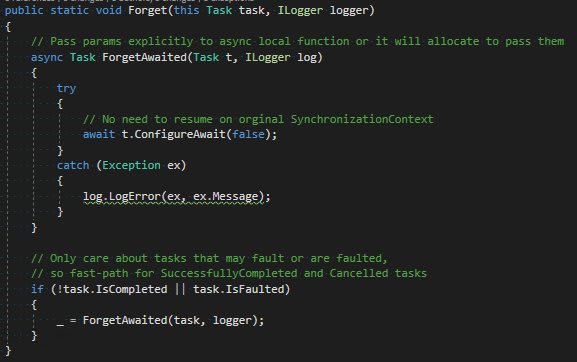This post originally appeared on Medium
Are you using ContinueWith in your async code?
For my future reference, this post is a quick summary of ASP.NET Core Architect David Fowler’s tweets:
 David Fowler@davidfowl
David Fowler@davidfowl Are you using ContinueWith in your async code? If yes? Why? #dotnetcore #aspnetcore07:12 AM - 26 Sep 2018
Are you using ContinueWith in your async code? If yes? Why? #dotnetcore #aspnetcore07:12 AM - 26 Sep 2018
So, here we go.
- Async state machines, though they have creation overhead are easier to debug. They can and will be further optimized in the future (on the runtime side).
- They execute synchronously if the task is already complete, something that
ContinueWithdoesn’t do this unless you specify the right set of flags. - Calling
ContinueWithallocates another task per operation (it wraps your delegate in a task object) instead of re-using the state machine instance as the continuation. So you’re static callback is then wrapped in a ContinuationTask object. That then also gets wrapped in another continuation object and attached to the list of Task continuations…. Task itself is also is optimized for async/await over everything else.
For example:
if (!task.IsCompleted)
{
return FinishAsync(task);
}
private async Task FinishAsync(Task task)
{
try
{
await task;
}
catch (Exception ex)
{
Log(.....)
}
}
-
ContinueWithallocates more than using async await. In fact, in .NET Core Task is very optimized for async await code paths and allocates less thanContinueWith. - The state machine’s overhead is a concern when you finish synchronously, not asynchronously.
- If you take into account the whole “cost,” including the state machine generation, async/await is still lighter than just using
ContinueWithin this situation. At least on .NET Core it is. -
ContinueWithneeds to capture the execution context. That’s going to mean at least an object that has both your callback and _ _options. - In the async await case, the state machine starts off as a
structand once you go async it is then boxed into an object, that boxing allocation is basically reused for everything.
Last but not least, also worth to check tweet thread:

 Ben Adams@ben_a_adams
Ben Adams@ben_a_adams @davidfowl @0omari0 @ThrowATwit @jbogard @DanielSilv9 @MoiTrades @marc_data So back to; with local function at top for @jbogard's .editorconfig23:41 PM - 26 Sep 2018
@davidfowl @0omari0 @ThrowATwit @jbogard @DanielSilv9 @MoiTrades @marc_data So back to; with local function at top for @jbogard's .editorconfig23:41 PM - 26 Sep 2018
Check out this Async Guidance from David Fowler ✨
Summary
Use async/await.






Top comments (0)